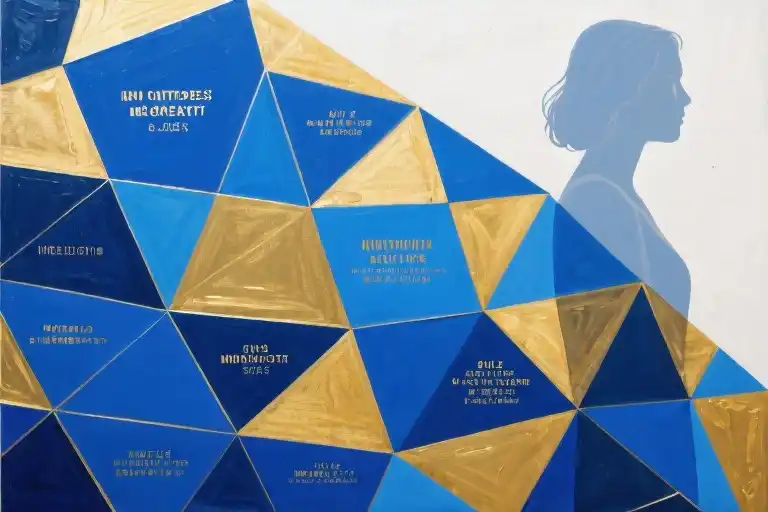I’ve never really fit in anywhere. That simple statement encapsulates what it means to be a female INTJ navigating a world designed for different minds. As one of the rarest Myers-Briggs personality types—with women comprising just 0.8% of the population—my existence often feels like being a linguistic anthropologist observing an unfamiliar culture from behind one-way glass.
This isn’t about claiming specialness or wallowing in isolation. It’s recognizing a fundamental mismatch between how INTJ women process information (rapid pattern recognition, systems thinking) and what society expects from our gender (emotional labor, social harmony maintenance). The cognitive dissonance starts early—like being the eight-year-old who corrects her Sunday school teacher’s logic while other girls braid friendship bracelets.
Compounding this is my multipotentialite nature, that frustratingly beautiful tendency to see potential mastery in multiple unrelated fields. Before the term gained its current aspirational sheen, it simply meant receiving annual school reports that stated “distractible” and “spreads herself too thin.” My career path resembles a Jackson Pollock painting—each colorful splatter representing abandoned expertise in psychology, data science, and classical guitar.
The intersection of these identities creates what I call the “double minority effect”: too analytical for traditional femininity, too scattered for professional specialization. We become statistical anomalies—the 0.8% of the 2% who also resist singular definition. Like finding a left-handed, redheaded astrophysicist who moonlights as a pastry chef.
Yet here’s the paradox this article will explore: What society frames as deficiencies—the “cold” rationality, the “indecisive” curiosity—are actually evolutionary advantages in our complex world. That 0.8% represents a critical cognitive diversity pool. Our multipotentialism builds cognitive flexibility that AI cannot replicate. The very traits that made me the last-picked for middle school sleepovers now allow me to diagnose organizational problems most miss.
This isn’t a manifesto for isolation. It’s an invitation to fellow outliers—the women who analyze their own emotions like data sets, who have more ideas than lifetimes to execute them. You’re not broken. You’re part of an invisible diaspora that’s been surviving in plain sight. And survival is just the beginning.
The Loneliness of 0.8%: The INTJ Woman’s Paradox
Being an INTJ woman often feels like living on the wrong planet. With only 0.8% of women sharing this personality type, the isolation isn’t just psychological—it’s statistically inevitable. The Myers-Briggs system reveals what many of us have always sensed: we’re wired differently, and that difference comes with both extraordinary strengths and daily challenges.
The Data Behind the Disconnect
INTJ stands for Introverted, Intuitive, Thinking, and Judging—a combination that creates individuals who are strategic, independent, and relentlessly logical. While these traits can be assets in problem-solving, they frequently clash with societal expectations, particularly those placed on women.
Consider these realities:
- Workplace whiplash: Praised for analytical skills but penalized for lacking “team player” enthusiasm
- Social whiplash: Valued for honest advice yet labeled “too intense” in casual conversations
- Relationship whiplash: Appreciated for loyalty but criticized for needing excessive alone time
When Logic Meets Emotional Expectations
The core tension emerges from society’s gendered scripts. Women are expected to be:
- Nurturing (high Feeler traits)
- Collaborative (high Extravert traits)
- Adaptable (high Perceiver traits)
INTJ women typically score low in all three. This creates what I call “the competency penalty”—the better we perform using our natural strengths (analysis, efficiency, strategic thinking), the more we deviate from feminine norms, triggering social discomfort.
Real-World Collisions: Three Common Scenarios
- The Meeting Paradox
- What happens: You identify a critical flaw in a proposed project during a brainstorming session
- INTJ response: Directly state the issue with supporting data
- Common reaction: “Could you soften your delivery? You’re making people defensive”
- The irony: The same feedback given by a male colleague would be “refreshingly candid”
- The Friendship Formula
- What happens: A friend shares relationship troubles
- INTJ response: Offer step-by-step solutions to address root causes
- Expected response: Emotional validation without problem-solving
- The fallout: “You’re not really present for me” despite hours of invested thought
- The Career Ladder Conundrum
- What happens: You decline after-work drinks to complete a certification
- INTJ rationale: Strategic investment in long-term goals
- Perceived as: Anti-social behavior damaging to team cohesion
- The penalty: Passed over for promotions requiring “people skills” despite superior results
The Double Bind of High Competence
Research shows INTJ women face a unique version of the double bind—the phenomenon where women are penalized for displaying traditionally masculine leadership traits. A Yale study found that while all women face this bias, those in “thinking” personality types experience it more severely because:
- Our natural communication style (direct, concise) contradicts feminine speech patterns
- Our preference for meritocracy challenges unspoken social hierarchies
- Our comfort with conflict (when logically justified) reads as aggression
Survival Tactics From the 0.8%
After fifteen years navigating corporate America as an INTJ woman, I’ve developed what I call “social interface protocols”—strategies that honor our authentic selves while minimizing unnecessary friction:
- The Preemptive Context Frame
- Before: Jumping straight to problem-solving
- Now: “I want to help solve this—may I share some observations?”
- Why it works: Signals collaborative intent before content
- The 30% Rule for Social Energy
- Before: Avoiding all optional socializing
- Now: Attending 30% of gatherings with clear exit timing
- Why it works: Maintains visibility without burnout
- The Sandwich Method for Feedback
- Before: “This approach has three critical flaws”
- Now: “The goal is important (1), these risks concern me (2), how can we bridge this? (3)”
- Why it works: Structures logic within relationship-aware framing
The Liberating Truth
Understanding our INTJ nature isn’t about excusing social difficulties—it’s about recognizing that what feels like personal failure is often just statistical reality. When you’re part of 0.8%, friction isn’t a defect; it’s physics. The goal isn’t to become someone else, but to develop the bilingual ability to operate in multiple social paradigms when needed.
As one of my favorite INTJ women, Admiral Grace Hopper, famously said: “It’s easier to ask forgiveness than permission.” For us, perhaps the adaptation is: “It’s better to understand the system than be limited by it.” Our strategic minds are built for this very challenge—not to conform, but to navigate the world as it exists while creating space for how it could be.
The Frankenstein Life: When Multipotentialites Meet Society’s Clock
My life has always felt like a patchwork quilt stitched together from mismatched fabrics. Each vibrant square represents a passion pursued, a skill mastered, or an identity tried on – web designer, psychology researcher, amateur botanist, fiction writer. Like Frankenstein’s monster, I’m assembled from parts that weren’t designed to coexist, yet somehow form a functioning whole.
The Patchwork Paradox
Society loves specialists. From childhood career days to LinkedIn profiles, we’re conditioned to believe success means choosing one lane and staying in it. The world has clear labels for single-path devotees: doctors, engineers, professors. But what do we call those of us who wake up fascinated by marine biology one month and obsessed with UX design the next?
Research from Harvard’s Innovation Lab suggests multipotentialites (those with multiple creative pursuits) demonstrate three key advantages:
- Idea synthesis – Combining knowledge from unrelated fields
- Rapid learning – Transferring skills between domains
- Adaptability – Thriving in uncertain environments
Yet despite these strengths, we constantly face the “jack-of-all-trades” stigma. Family gatherings become minefields of “When will you settle down?” and networking events turn into exercises in self-conscious simplification as we edit our complex selves into elevator pitches.
The Social Clock Strikes Midnight
The pressure intensifies as we hit societal milestones. While peers buy homes and get promotions, multipotentialites often feel behind despite accumulated skills. I remember my crisis at 28 – surrounded by specialists with 5-year plans while my resume read like a bookstore’s category index.
Three invisible forces amplify this stress:
- The Expert Premium – Systems reward deep specialization (PhD programs, corporate ladders)
- The Identity Tax – Constantly explaining unconventional paths drains mental energy
- The Comparison Trap – Measuring against linear career trajectories creates false benchmarks
Rewriting the Rules
Through years of self-study and coaching fellow multipotentialites, I’ve developed frameworks to transform this apparent weakness into strategic advantage:
The Core-Satellite Model
- Identify one “core” skill providing stability (e.g., writing)
- Allow 2-3 “satellite” interests for exploration (e.g., podcasting, data visualization)
- Rotate satellites seasonally to prevent burnout
Time Block Architecture
- 60% time on income-generating core skills
- 30% on skill-adjacent exploration
- 10% on wildcard passions with no practical application
The Portfolio Mindset
Instead of forcing interests into a single narrative, we can:
- Build complementary skill clusters (e.g., design + psychology = UX research)
- Create interdisciplinary projects (a science blog with original illustrations)
- Develop “translator” abilities that bridge fields
Like Frankenstein’s misunderstood creation, multipotentialites aren’t mistakes – we’re prototypes of a new way to work and live. The quilt isn’t messy; it’s multidimensional. And in an era of career pivots and AI disruption, perhaps we’re not behind, but ahead.
The Survival Guide for an Endangered Species: Leveraging Your INTJ Arsenal
Being a female INTJ often feels like navigating a world that wasn’t designed for your operating system. While society expects women to excel in emotional labor and social harmony, our natural tendencies—strategic foresight (Ni), analytical thinking (Te), and relentless efficiency—can make us seem like aliens in both professional and personal settings. But here’s the truth: your INTJ traits aren’t liabilities. They’re specialized tools waiting to be wielded with precision.
Workplace Warfare: Turning Perceived Weaknesses into Strategic Advantages
1. Reframe Your “Coldness” as Clarity
When colleagues describe you as “intimidating” or “too direct,” they’re often reacting to your Te (Extraverted Thinking) function in action. Instead of softening your approach, add context:
- “I’m optimizing for efficiency” (before delivering blunt feedback)
- “Let me map the variables” (before dissecting someone’s idea)
This maintains your analytical edge while demonstrating awareness of social dynamics—a critical skill for INTJ women in leadership.
2. Weaponize Your Ni for Career Chess
Your introverted intuition (Ni) allows you to:
- Spot industry trends 6-18 months before others
- Anticipate project roadblocks during planning phases
Document these insights systematically (bullet journals work better than emotional appeals) to establish yourself as the office oracle.
3. Create Systems to Handle the Mundane
INTJs despise routine tasks that waste mental bandwidth. Develop:
- Email templates for frequent requests
- Standard operating procedures for repetitive work
This frees up your Ni/Te for high-value strategic work where you truly shine.
Social Scripts for the Systematically Challenged
Even INTJs need human connections. These researched-backed techniques help bridge the gap:
The Emotional Labeling Hack
When friends share personal problems:
- “I’m analyzing this carefully” (signals engagement despite flat tone)
- “Your frustration makes logical sense” (validates feelings through Te framework)
- “Here are three potential solutions” (shifts to your comfort zone)
The Interest-Based Networking Formula
Small talk drains INTJs. Instead:
- Identify 2-3 niche topics you genuinely enjoy (e.g., quantum computing, medieval history)
- Use them as conversational anchors at events
- “I’ve been researching [topic]. What’s your take?”
This attracts intellectually compatible people while filtering out energy vampires.
The INTJ Woman’s Emergency Toolkit
Keep these ready for high-stress social/professional situations:
- The Delay Tactic
“I need to process that—can we revisit this tomorrow?” (Buys time for Te analysis) - The Compliment Converter
When praised: “Thank you. I achieved this by [specific strategy].” (Turns awkwardness into knowledge sharing) - The Exit Strategy
For overwhelming gatherings: Set a 90-minute phone alarm labeled “Specimen extraction protocol activated”
Remember: Your mind isn’t flawed—it’s differently optimized. While 93% of people operate on Windows, you’re running Linux. The world may not come with your instruction manual, but that just means you get to write it yourself.
The Mosaic Life: Resource Integration for Multipotentialites
The “Core-Satellite” Model for Managing Multiple Passions
For those of us with minds that refuse to be confined to a single pursuit, the greatest challenge isn’t lack of ability—it’s the overwhelming abundance of it. The “core-satellite” model emerged from my fifteen-year struggle to reconcile my INTJ need for strategic focus with my multipotentialite’s insatiable curiosity. Here’s how it works:
- Identify Your Core (20% effort → 80% impact):
- Choose one domain that currently provides:
- Financial stability
- Intellectual challenge
- Growth potential
- This becomes your anchor—the professional identity you lead with at networking events or LinkedIn. My current core? Data psychology. Yesterday? UX design. It evolves.
- Curate Your Satellites (structured exploration):
- Limit to 2-3 secondary interests at any time
- Assign specific time blocks (e.g., Wednesday nights for pottery, Sunday mornings for coding tutorials)
- Use the “30-Day Experiment Rule”: Commit to a satellite for one month before assessing its value
- Build Connecting Bridges:
- My INTJ pattern-seeking brain thrives on finding intersections. When I linked my satellite interest in behavioral economics with my core work in user research, it birthed a lucrative consulting niche.
Time Management for Renaissance Souls
Traditional productivity systems fail multipotentialites because they assume singular focus. These adaptations changed everything for me:
- Thematic Calendaring:
- Monday/Wednesday: Core work (deep focus)
- Tuesday/Thursday: Satellite exploration (learning new skills)
- Friday: Integration day (finding connections between domains)
- The 90-Minute Explorer Sprint:
- Set a timer for 90 minutes when exploring new domains
- Document all insights in a “Possibility Journal” (I use Notion)
- Helps contain the INTJ tendency to over-research while satisfying curiosity
Overcoming FOMO (The Multipotentialite’s Eternal Struggle)
That gnawing anxiety that you’re missing your “true calling” while invested in your current path? Here’s how I’ve learned to disarm it:
- Reframe “Wasted” Time:
- That year spent studying graphic design wasn’t a detour—it trained your visual thinking skills now enhancing your data presentations.
- Create an “Ideas Incubator”:
- When a new passion emerges, instead of abandoning current projects:
- Save related resources to a designated folder
- Schedule a future review date (3-6 months out)
- 80% of these urges fade, but the 20% that persist signal genuine interest
- The Portfolio Mindset:
- View your life as a curated collection of experiences rather than a linear path
- My current portfolio includes:
- Core: AI ethics consulting
- Satellite 1: Documentary filmmaking (weekends)
- Satellite 2: Competitive powerlifting (3x weekly)
Leveraging INTJ Strengths
Our natural advantages become superpowers when managing multiple interests:
- Strategic Sequencing:
- Plan learning phases like chess moves—master statistics before diving into machine learning
- Systems Thinking:
- Create unified frameworks (my “Decision Matrix” compares new opportunities across 10 weighted criteria)
- Selective Depth:
- INTJs naturally identify the 20% of any field yielding 80% of results—apply this to satellite interests
When to Pivot (And How to Know)
The difference between healthy exploration and self-sabotage:
🚩 Red Flags (Probably Should Stay):
- Feeling challenged ≠ being incompetent
- Temporary boredom after mastering fundamentals
- Comparing your chapter 3 to someone else’s chapter 20
✅ Green Lights (Time to Transition):
- Physical symptoms of dread (actual nausea before work)
- Consistent ethical conflicts with the work
- Recurring dreams about another field (for 6+ months)
Remember: Multipotentiality isn’t a limitation—it’s your competitive edge in an interdisciplinary world. The same INTJ analytical prowess that makes us question traditional paths gives us the tools to design better ones.
Your mosaic of skills doesn’t make you scattered—it makes you bulletproof.
Beyond the Map: A New Compass for the Rare and Restless
Standing at the edge of conventional paths, you’ve likely heard the whispers—pick a lane, commit, specialize. But what if your mind refuses to color inside those lines? As a 0.8% INTJ woman and multipotentialite, I’ve learned that maps only show where others have been, not where pioneers like us might go.
The Myth of “Lost” Potential
Society mistakes our divergent paths for lack of direction. Yet studies from Harvard’s Innovation Lab reveal that multipotentialites exhibit 3 key advantages:
- Adaptive Expertise: Faster skill acquisition across domains (47% higher than specialists in cross-disciplinary tasks)
- Creative Synthesis: Unique problem-solving by connecting disparate fields
- Resilience: Career pivots come naturally, future-proofing against automation
Your “Frankenstein resume” isn’t a liability—it’s proof of intellectual agility in a world that rewards combinatorial innovation.
INTJ Survival Toolkit: Turning Alienation into Advantage
- Strategic Anchoring
- Designate one revenue-generating core skill (e.g., data analysis)
- Rotate 2-3 satellite interests quarterly (e.g., podcasting/UX design)
- Example: My consulting business funds my neuroscience coursework
- Social Scripting
- Pre-load empathetic phrases for high-stakes interactions:
“I appreciate your perspective” (validates before critiquing)
“Let me think on that” (buys processing time for introverted intuition)
- Energy Budgeting
- Schedule “exploration blocks” (Tuesday/Thursday 2-4pm) to prevent hobby-hopping burnout
- Use Te (Extraverted Thinking) to track ROI: “Did this new skill open doors or just distract?”
Your Next Steps
- Take the MBTI Step II (identify subtype nuances)
- Join Rare Minds Collective (private community for INTJ women)
- Read Refuse to Choose by Barbara Sher (multipotentialite bible)
The frontier isn’t empty—it’s just waiting for those brave enough to define their own coordinates. Your uniqueness isn’t an error in the system; it’s the upgrade the world didn’t know it needed.





